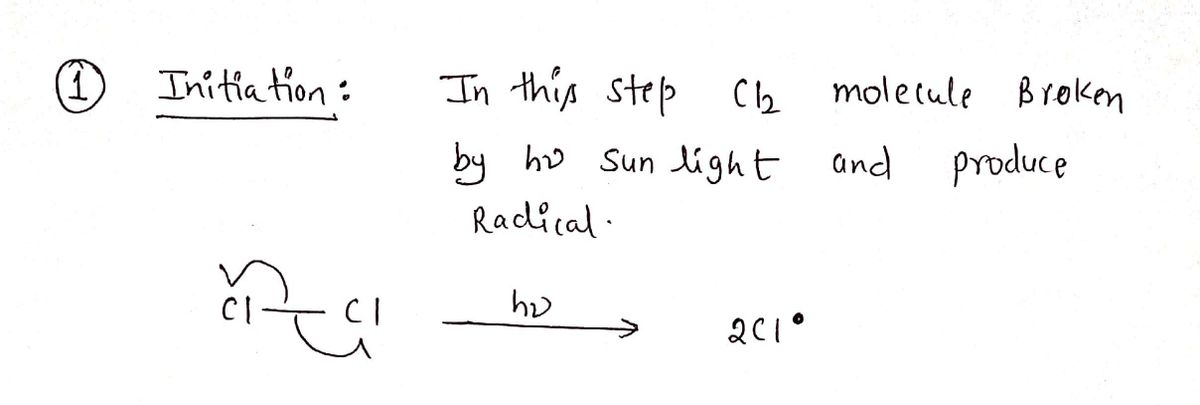Chemistry
10th Edition
ISBN:9781305957404
Author:Steven S. Zumdahl, Susan A. Zumdahl, Donald J. DeCoste
Publisher:Steven S. Zumdahl, Susan A. Zumdahl, Donald J. DeCoste
Chapter1: Chemical Foundations
Section: Chapter Questions
Problem 1RQ: Define and explain the differences between the following terms. a. law and theory b. theory and...
Related questions
Question
Using arrows show the flow of electron, write a stepwise mechanism for the following reaction.

Transcribed Image Text:The image illustrates a chemical reaction involving the halogenation of an alkane.
**Description of the Reaction:**
- On the left side, the structure depicts 2-methylbutane, an alkane with two methyl groups and a butyl chain.
- The reaction involves chlorine gas (\( \text{Cl}_2 \)) and is initiated by light energy (\( h\nu \)), indicating a photochemical halogenation process.
- On the right side, the resulting product is 2-chloro-2-methylbutane, where a chlorine atom has replaced a hydrogen atom on the tertiary carbon atom adjacent to the methyl groups.
**Reaction Mechanism Overview:**
1. **Initiation Step:**
- The \( \text{Cl}_2 \) molecule is split into two chlorine radicals (\( \text{Cl} \cdot \)) by light energy (\( h\nu \)).
2. **Propagation Steps:**
- A chlorine radical abstracts a hydrogen atom from the alkane, forming hydrochloric acid (\( \text{HCl} \)) and a carbon radical.
- The carbon radical reacts with another \( \text{Cl}_2 \) molecule to form the chloroalkane and regenerate a chlorine radical, propagating the chain reaction.
This reaction is a classic example of free radical halogenation in organic chemistry.
Expert Solution
Step 1

Step by step
Solved in 3 steps with 3 images

Knowledge Booster
Learn more about
Need a deep-dive on the concept behind this application? Look no further. Learn more about this topic, chemistry and related others by exploring similar questions and additional content below.Recommended textbooks for you

Chemistry
Chemistry
ISBN:
9781305957404
Author:
Steven S. Zumdahl, Susan A. Zumdahl, Donald J. DeCoste
Publisher:
Cengage Learning

Chemistry
Chemistry
ISBN:
9781259911156
Author:
Raymond Chang Dr., Jason Overby Professor
Publisher:
McGraw-Hill Education

Principles of Instrumental Analysis
Chemistry
ISBN:
9781305577213
Author:
Douglas A. Skoog, F. James Holler, Stanley R. Crouch
Publisher:
Cengage Learning

Chemistry
Chemistry
ISBN:
9781305957404
Author:
Steven S. Zumdahl, Susan A. Zumdahl, Donald J. DeCoste
Publisher:
Cengage Learning

Chemistry
Chemistry
ISBN:
9781259911156
Author:
Raymond Chang Dr., Jason Overby Professor
Publisher:
McGraw-Hill Education

Principles of Instrumental Analysis
Chemistry
ISBN:
9781305577213
Author:
Douglas A. Skoog, F. James Holler, Stanley R. Crouch
Publisher:
Cengage Learning

Organic Chemistry
Chemistry
ISBN:
9780078021558
Author:
Janice Gorzynski Smith Dr.
Publisher:
McGraw-Hill Education

Chemistry: Principles and Reactions
Chemistry
ISBN:
9781305079373
Author:
William L. Masterton, Cecile N. Hurley
Publisher:
Cengage Learning

Elementary Principles of Chemical Processes, Bind…
Chemistry
ISBN:
9781118431221
Author:
Richard M. Felder, Ronald W. Rousseau, Lisa G. Bullard
Publisher:
WILEY